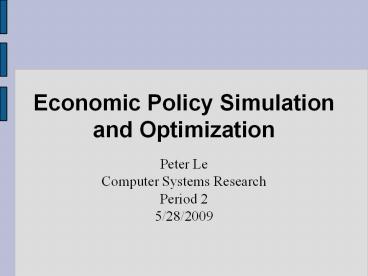Economic Policy Simulation and Optimization - PowerPoint PPT Presentation
Title:
Economic Policy Simulation and Optimization
Description:
Government/Citizen relationship over a 12 year cycle ... Crossbreed pairs with best data. Converges to local maxima/minima. Problems. Locality ... – PowerPoint PPT presentation
Number of Views:22
Avg rating:3.0/5.0
Title: Economic Policy Simulation and Optimization
1
Economic Policy Simulation and Optimization
- Peter Le
- Computer Systems Research
- Period 2
- 5/28/2009
2
Purpose
- Create feasible and simple economic (taxation and
welfare) model - Implement optimization algorithm effectively
- Help improve public policy through test runs and
simulation data
3
Economic Policy
- Government regulation
- Citizen feedback
- Changes depending on demographics and economy
4
Simulation
- Government/Citizen relationship over a 12 year
cycle - Citizen objects consume, produce, spend, and are
taxed - Government welfare based on need/approval
- Society assessment based on citizen
self-assessment, approval ratings, and government
self-assessment
5
Problems to Solve
- Realistic economic cycle
- Feasible demographics
- Identifying ramifications of different policy
change
6
Simulation Optimization
- Retrieve raw data and assess
- Multiple variables mean the best run isnt
necessarily optimal - Optimization
7
Background
- Data on taxes and welfare
- Higher taxes, more government programs
- Upward trend of spending
- Not much previous research
- Happiness assessments
8
Development
- Q1
- Preliminary research
- Starting the model
- Q2
- Finishing the model
- Data handling and analysis
- Q3
- Optimization research
- Coding the optimization stage
- Q4
- Final optimization program
- Assessment of best policies
9
The Cycle
- Given Citizen traits Wealth, wealthAssessment
- Given Government traits Wealth,
wealthAssessment, approvalRating, taxRate,
welfareRate, salesTaxRate - Monthly assessments to track progress
10
Approval
- Government
- Wealth
- WealthAssessment
- Approval Rating
- Tax Rate
- Sales Tax Rate
- Responsiveness
Taxes
Welfare
- Population
- Wealth
- Approval
- WealthAssessment
- Work Rate
- Spending Rate
FitnessEvaluation
11
The Model
- Java, JGrasp
- Iterative Model allowing for multiple
governments, citizen pools - Input data ? Read data ? Cycle ? Print data ?
Analyze data - GNUPlot for data display
- Data somewhat arbitrary now but will look for
more realistic data - Optimization and randomization mitigates need for
solid data
12
Why Java?
- Alternatives MASON, NetLogo
- Not pre-packaged, but easily modifiable
- Agent based approach with outside genetic
algorithm warrants relatively complex code - Handling input/output
13
Optimization
- Methods
- Hill Climbing
- Genetic Algorithm
- Genetic algorithm
- Run tests
- Retrieve data, determine the best and breed
them - Repeat
- Advantage over Hill Climbing
14
Genetic Algorithm
- Stochastic process
- Evolutionary process
- Crossbreed pairs with best data
- Converges to local maxima/minima
- Problems
- Locality
- Lots of variables
15
Data Output
Model
Assessment
Sorting
Basic Genetic Algorithm
Selection
Breeding
Mutation
16
Genetic Algorithm Test
Generation 1
Generation 6
17
Specific Issues
- Multivariate crossover
- Tax rate (Income and sales)
- Welfare rate and criteria (Responsiveness)
- Overcoming local maxima
- Varying degrees of importance
- of generations
18
Model Results
19
Run 1
Government Wealth
Civilian Aggregate Wealth
Economic Assessment
20
Run 2
Government Wealth
Civilian Aggregate Wealth
Economic Assessment
21
Run 9
Government Wealth
Civilian Aggregate Wealth
Economic Assessment
22
Model Discussion
- Dual-curve behavior elusive
- Economic assessment generally curves downwards
after variation lessens - Governments gain wealth steadily
- Civilians gain or lose wealth, but converge to an
equilibrium
23
Model Discussion
- Government wealth always increases without
deceleration - Some sort of equilibrium for aggregate Citizen
wealth - Assessment is erratic
- Based on immediately previous data
- Based on ratios, large drops/gains are forgotten
24
Genetic Algorithm Results
- Early trial Indication of a problem
- Trial number, generation, assessment
- 0, 0, 1.0047507115885828
- 0, 1, 1.0083489109062942
- 0, 2, 1.4181731746426252
- 0, 3, 2.0526606700631387
- 0, 4, NaN
- 0, 5, NaN
- 0, 6, NaN
- 0, 7, NaN
- 0, 8, NaN
- 0, 9, NaN
NaN Not a Number
25
Test runs
- Most result in higher assessments
- Some anomalic low assessments
26
Whats going on?
- Ratio based assessment
- Large debt or profit or zeros create calculation
problems - Government basically loses too much money
- Genetic algorithm doesnt significantly result in
lower assessments in most runs, but clearly there
is a problem - Local maxima
27
Discussion
- If the citizenrys gains are more drastic than
the governments losses, the citizenry approves - Pattern of over-spending
- People want low taxes but benefits
- High spending, low revenue ? debt
- Government spending doesnt necessarily help the
economy - Model doesnt change policy dynamically within a
run
28
Aftermath
- Modifiability accomplished
- Initial data not particularly positive
- Many variables ? data is hard to read
- What is important?
- Sustainable economies
- Genetic algorithm is a success, but the models
success ultimately lies in the assessment
29
Things to Work On
- A more fair assessment of the society
- Current weights government and population
importance equally - One group may fail but the assessment isnt
indicative if the other succeeds enough - Optimization tweaking
- Test more situations different government
structures
30
Lessons Learned
- Variable data sets
- Inferring trends and cause-effect relationships
from data - A clear objective is essential

